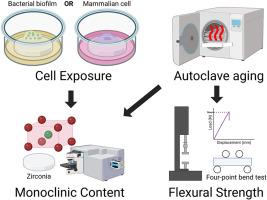Simulated oral environment affects zirconia aging and mechanical strength
IF 3.5
2区 医学
Q2 ENGINEERING, BIOMEDICAL
Journal of the Mechanical Behavior of Biomedical Materials
Pub Date : 2025-10-01
DOI:10.1016/j.jmbbm.2025.107217
引用次数: 0
Abstract
Background
Zirconia is an emerging alternative to titanium for dental implant systems. However, zirconia surfaces can deteriorate under aqueous conditions, thereby compromising mechanical performance. The goal of this study was to assess the impact of biological exposure or aging simulating the oral cavity on the surface integrity and mechanical strength of surface-treated zirconia.
Methods
Partially yttria- or magnesia-stabilized zirconia specimens were polished, acid-etched, or sandblasted. Zirconia disks were exposed to mammalian cells or bacteria. Surface degradation via tetragonal-to-monoclinic phase transformation was assessed by Raman microscopy. Zirconia bars were subjected to accelerated aging by exposure to autoclave steam. Surface morphology was examined by scanning electron microscopy, and mechanical strength was measured using four-point bend test loading until failure.
Results
Early-colonizing oral bacteria significantly increased monoclinic content ∼5-fold on acid-etched yttria-stabilized zirconia versus control (p < 0.05). Surface monoclinic content on acid-etched zirconia increased rapidly (54.6 ± 9.3 %) after 4 h of aging before plateauing (77.0 ± 5.7 %) after 20 h. In contrast, polished or sandblasted zirconia exhibited minimal monoclinic content (∼4 %) after 4 h that gradually increased to ∼40 % by 20 h. Acid-etching treatment significantly reduced the flexural strength of zirconia (585 ± 34 MPa) while sandblasting variants were statistically similar (922 ± 52 MPa) to machined control (921 ± 74 MPa). Aging reduced the flexural strength of machined or sandblasted zirconia, which was significant (p < 0.05) for machined zirconia (782 ± 178 MPa).
Conclusions
Acid-etching and/or exposure to acidic environment increase zirconia susceptibility to surface degradation, impacting its surface and mechanical properties.

模拟口腔环境影响氧化锆老化和机械强度
背景氧化锆是牙科种植体系统中钛的新兴替代品。然而,氧化锆表面在水环境下会变质,从而影响机械性能。本研究的目的是评估生物暴露或模拟口腔老化对表面处理氧化锆表面完整性和机械强度的影响。方法对部分氧化钇或镁稳定的氧化锆试样进行抛光、酸蚀或喷砂处理。氧化锆盘暴露于哺乳动物细胞或细菌中。通过拉曼显微镜评估四方到单斜相变的表面降解。氧化锆棒暴露在高压灭菌器蒸汽中加速老化。通过扫描电子显微镜检查表面形貌,并使用四点弯曲试验加载直至失效来测量机械强度。结果与对照组相比,早期定植的口腔细菌在酸蚀钇稳定氧化锆上的单斜晶含量显著增加约5倍(p < 0.05)。酸蚀氧化锆的表面单斜含量在时效4小时后迅速增加(54.6±9.3%),而在20小时后镀平(77.0±5.7%)。相比之下,抛光或喷砂氧化锆的表面单斜含量在4小时后最低(~ 4%),在20小时后逐渐增加到~ 40%。酸蚀处理显著降低了氧化锆的抗弯强度(585±34 MPa),而喷砂处理的变化与加工控制(921±74 MPa)相似(922±52 MPa)。老化降低了机械氧化锆和喷砂氧化锆的抗弯强度,其中机械氧化锆的抗弯强度显著降低(p < 0.05)(782±178 MPa)。结论酸蚀和/或暴露于酸性环境中会增加氧化锆的表面降解敏感性,影响其表面和力学性能。
本文章由计算机程序翻译,如有差异,请以英文原文为准。
求助全文
约1分钟内获得全文
求助全文
来源期刊

Journal of the Mechanical Behavior of Biomedical Materials
工程技术-材料科学:生物材料
CiteScore
7.20
自引率
7.70%
发文量
505
审稿时长
46 days
期刊介绍:
The Journal of the Mechanical Behavior of Biomedical Materials is concerned with the mechanical deformation, damage and failure under applied forces, of biological material (at the tissue, cellular and molecular levels) and of biomaterials, i.e. those materials which are designed to mimic or replace biological materials.
The primary focus of the journal is the synthesis of materials science, biology, and medical and dental science. Reports of fundamental scientific investigations are welcome, as are articles concerned with the practical application of materials in medical devices. Both experimental and theoretical work is of interest; theoretical papers will normally include comparison of predictions with experimental data, though we recognize that this may not always be appropriate. The journal also publishes technical notes concerned with emerging experimental or theoretical techniques, letters to the editor and, by invitation, review articles and papers describing existing techniques for the benefit of an interdisciplinary readership.
 求助内容:
求助内容: 应助结果提醒方式:
应助结果提醒方式:


